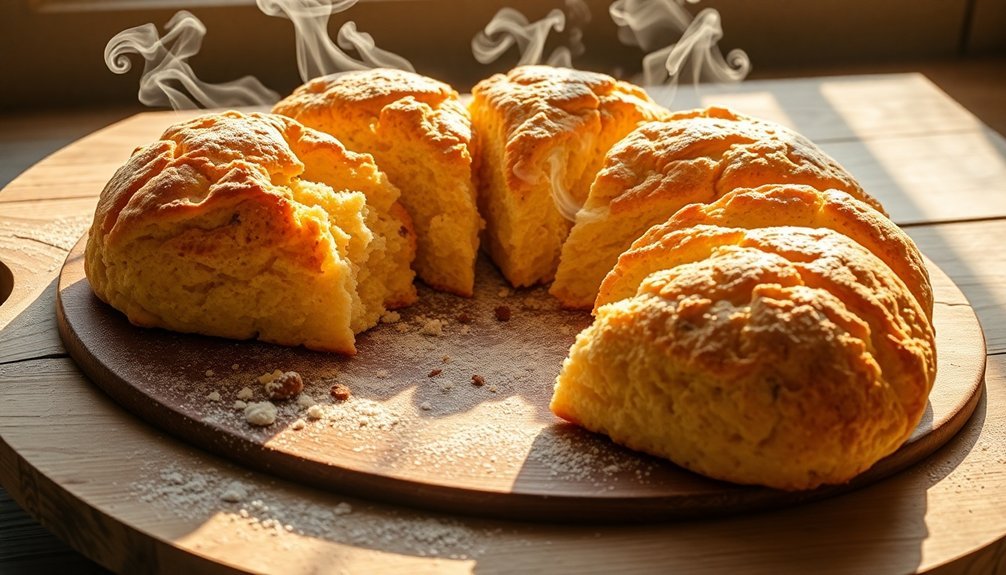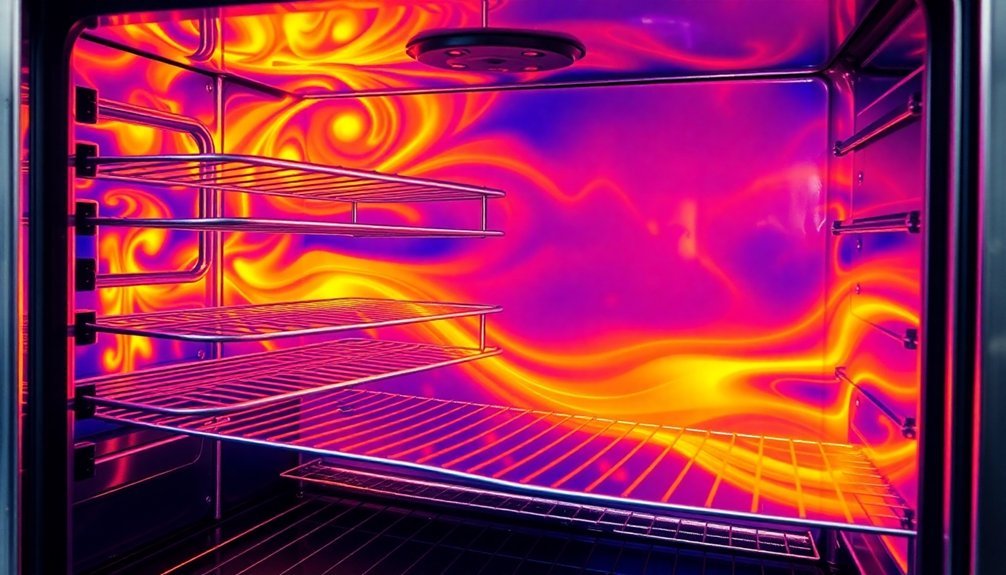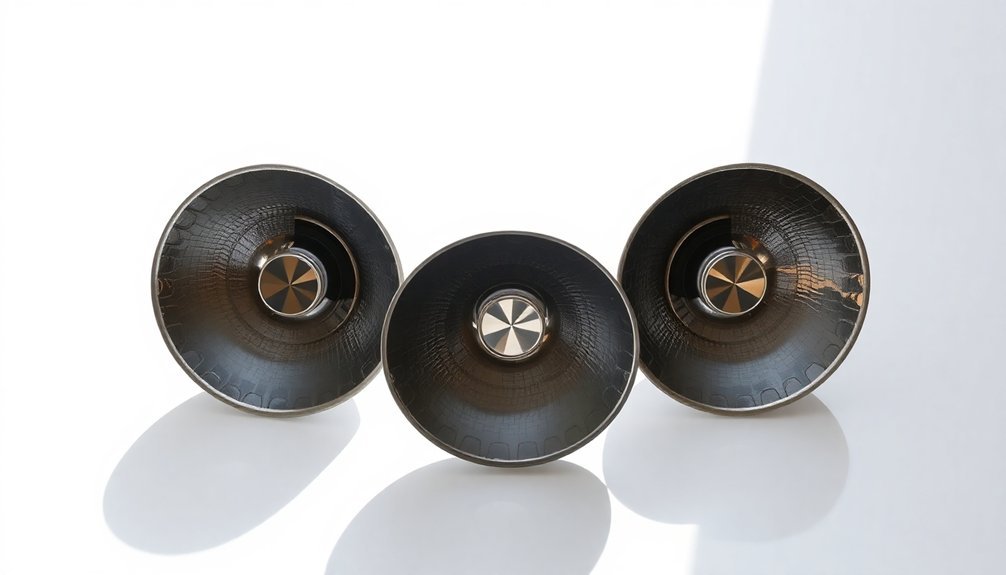For successful sun-baked scones, you'll need five key elements. Start with a well-insulated solar oven using a pizza box lined with foil and black paper. Keep your ingredients ice-cold, especially the butter, which should be grated into pea-sized pieces. Mix quickly but gently, combining dry ingredients first, then cutting in fat until you achieve a breadcrumb texture. Position your oven for maximum sun exposure – 45° east in morning, flat at midday, 45° west in afternoon. Allow 1-1.5 hours of baking time at 275-325°F, and remember to preheat for 30 minutes. These fundamentals will set you up to master the art of solar baking.
Preparing Your Solar Oven Setup

Building your solar oven starts with three essential components: a suitable box, proper insulation, and reflective surfaces.
You'll need a pizza box or similar cardboard container with a lid that creates a tight seal when closed. Cut a three-sided flap in the lid, leaving a one-inch border and one side attached to act as a hinge.
Line the bottom with black construction paper to maximize heat absorption, then add insulation using crumpled newspapers, hay, or sawdust around the cooking area. Cover the interior with aluminum foil, ensuring it's smoothly applied to reflect heat effectively.
You'll want to create a window by sealing the box's opening with two layers of plastic wrap – one on top and one on the bottom of the lid opening. This dual layer system helps maintain consistent cooking temperatures inside the oven.
For the reflective surface, cover the inner side of the cut flap with smooth aluminum foil, shiny side out.
You'll need to test the oven's functionality by adjusting the flap's angle using a ruler as a prop. Position your oven in direct sunlight, ideally between 11 am and 3 pm, and be prepared to adjust its position as the sun moves across the sky.
Cold Ingredients Matter
The secret to perfectly flaky sun-baked scones lies in keeping your ingredients ice-cold throughout the preparation process. When you're working with butter, make certain it's straight from the refrigerator or freezer. You'll want to grate or cube it into pea-sized pieces, which will create those coveted flaky layers as they melt slowly in your solar oven.
Don't overlook your dairy components and eggs. Keep your buttermilk or heavy cream thoroughly chilled, as cold dairy activates the baking powder more effectively and prevents premature butter melting. You'll also want to use cold eggs to maintain proper structure and prevent over-mixing. Adding sun dried tomatoes brings a burst of savory flavor to complement the buttery layers.
Once you've combined your ingredients, chill the dough for at least 15-20 minutes before baking. This essential step allows the gluten to relax and helps distribute the fat evenly, resulting in higher-rising scones with tender crumbs. If you're planning ahead, you can freeze the shaped dough wedges for later use.
Remember to work quickly and gently when handling your ingredients. Use a pastry cutter or two knives to work in the butter, and avoid over-kneading to maintain those precious cold butter pieces within the dough.
Quick Mixing Methods

Mastering quick mixing methods guarantees your sun-baked scones turn out perfectly every time. Start by combining your dry ingredients efficiently – if you've got a stand mixer, use the paddle attachment for a quick 30-second blend instead of sieving. Don't forget to incorporate any spices, herbs, or zests at this stage.
When it's time to cut in the fat, you've got several options. You can use a pastry cutter, work two knives in a scissor motion, or let your stand mixer do the work for about 5 minutes until you see breadcrumb-like texture. If you're using your fingers, work quickly to keep the butter cold and solid. Consider using unsalted butter for better control over the scone's saltiness and overall flavor enhancement.
For the wet ingredients, whisk them separately first, then create a well in your dry mixture. You'll want to add these gradually, folding gently with a rubber spatula. Don't overmix – you're just aiming to moisten everything evenly.
Finally, turn your dough onto a floured surface and work it quickly into shape. Whether you're cutting wedges or using a ring mold, remember to handle the dough minimally. This gentle treatment guarantees your sun-baked scones maintain their signature flaky texture.
Proper Sun Positioning
Now that you've mastered quick mixing techniques, proper sun positioning will make or break your outdoor baking success. While traditional scones benefit from touching placement in a hot oven, sun-baking requires careful positioning to maximize heat exposure. You'll want to arrange your scones in a single layer with slight spacing to allow sunlight to reach all surfaces.
| Time of Day | Scone Position | Temperature Goal |
|---|---|---|
| Morning (8-10am) | 45° angle east | 150-175°F |
| Midday (11am-1pm) | Flat horizontal | 175-200°F |
| Afternoon (2-4pm) | 45° angle west | 150-175°F |
| Late Day (5-6pm) | Elevated platform | 125-150°F |
Place your scones on a dark, heat-conducting surface like a cast iron skillet or black baking sheet. You'll need to maintain the cold ingredient principle, but work quickly to get them positioned before the butter starts warming. While traditional oven-baked scones touch for support, sun-baked versions need space for even heat distribution. Score your wedges deeply, leaving just enough connection to maintain shape during the longer baking process.
Solar Baking Time Guide

Successful sun-baked scones require carefully timed baking periods that differ greatly from traditional oven methods. You'll need to plan for 1 to 1.5 hours of baking time in your solar oven, maintaining temperatures between 275-325°F for ideal results.
Start by preheating your solar oven for 30-45 minutes before placing your scones inside. You'll want to use a solar oven thermometer to monitor the temperature throughout the baking process.
If you're baking on a cloudy day or experiencing windy conditions, you'll need to adjust your timing accordingly, as these factors can considerably impact your oven's temperature.
Your location and the time of year will affect your baking schedule. If you're closer to the Equator, you'll have more consistent sunlight and longer cooking windows.
Be prepared to turn your oven periodically to follow the sun's path, ensuring steady heat absorption. Remember that well-insulated ovens help maintain consistent temperatures during brief cloudy periods, but you may still need to extend your baking time.
Watch for visual cues of doneness rather than relying solely on predetermined timing, as weather conditions can vary daily.
Frequently Asked Questions
Can I Make Sun-Baked Scones on a Cloudy or Overcast Day?
You can make sun-baked scones on cloudy days, but you'll face reduced efficiency and longer baking times. It's better to use your conventional oven instead to guarantee consistent results and proper baking.
What's the Best Container Material for Solar Baking Scones?
You'll get the best results using a dark-colored Pyrex or ceramic dish with a lid. They absorb heat well and retain it efficiently. Line your container with aluminum foil for enhanced heat reflection and distribution.
How Do Seasonal Changes Affect Solar Baking Times for Scones?
You'll need to adjust your baking times seasonally: 45-60 minutes in summer's intense sun, about 1 hour in spring/fall's moderate light, and up to 2 hours during winter's weaker sunlight.
Will Altitude Affect My Solar-Baked Scone Recipe?
Yes, altitude will affect your solar-baked scones. You'll need to reduce leavening agents, add more liquid, and expect faster rising. Since solar baking's already slower, you may need extra time at higher elevations.
Can I Add Frozen Fruit to Solar-Baked Scones Without Affecting Baking Time?
No, you can't add frozen fruit without affecting baking time. You'll need extra time since frozen fruit adds moisture. Thaw and pat the fruit dry first to minimize the impact on your solar baking.
In Summary
You've now got all the essential tips for perfect sun-baked scones. Remember to set up your solar oven correctly, keep those ingredients cold, mix quickly but thoroughly, position your oven for ideal sun exposure, and follow the timing guidelines. Don't let cloudy days discourage you – with practice, you'll master the art of solar baking and enjoy fresh, delicious scones while saving energy.





Leave a Reply